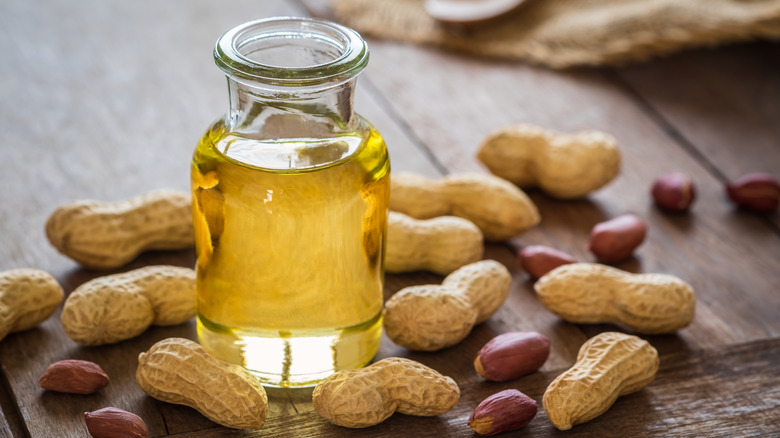The Best Type Of Peanut Oil To Use For Each Of Your Cooking Needs
Not all peanut oils are made equal. This popular cooking oil comes in a variety of types: The main three you'll likely encounter are refined, cold-pressed, and roasted peanut oil. Refined peanut oil is easily the most common one: It's usually stocked in grocery stores, and if the packaging isn't clear about which type of peanut oil it is, chances are it's this one. All peanut oils are made with a process of cleaning and crushing peanuts, effectively juicing out the oil. Refined oil is then bleached and deodorized. This eliminates a lot of color and flavor from the oil, making refined peanut oil very neutral tasting (that is, it shouldn't taste like peanuts). That processing also means it'll last longer on shelves — up to six months (one to two years if unopened). It has a high smoke point around 450 degrees Fahrenheit, making it especially good for deep-frying and stir fries (it's a common oil in Chinese cuisine). Correspondingly, refined peanut oil is a popular choice for fast food chains that do a lot of deep-frying, in large part because it doesn't absorb the flavor of other foods cooked in it. So, restaurants can cook a bunch of different ingredients in the same oil without the flavors crossing over.
Interestingly, refined peanut oil is often considered safe for those with peanut allergies, as its processing removes the proteins that cause allergic reactions — although allergy sufferers would be wise to carefully check the packaging and potentially consult a doctor before consuming it.
Then there's cold-pressed peanut oil
Cold-pressed peanut oil is sometimes also called "virgin" peanut oil. Making this oil follows the same initial steps as its refined sibling, but without the bleaching and deodorizing steps at the end (heat is also not applied to the oil, as might be done when producing refined peanut oils). Since this oil retains the peanut proteins that would otherwise be banished in the refining process, it's not considered safe for allergy sufferers.
You can expect cold-pressed peanut oil to have a peanutty scent and taste that you won't get from the refined version, although that flavor isn't usually super strong. This means it'll work with other ingredients without just inserting an overwhelming taste of peanuts. Its smoke point is around 340 degrees Fahrenheit, over 100 degrees lower than the refined oil. This means you won't want to use it in high heat settings like deep frying. Instead, it works better with salad dressings and marinades, where it can add an extra dimension of peanut flavor without necessarily dominating a dish. You could also use it to garnish dishes, drizzling some over at the end. Bear in mind the cuisines that work well with peanut oil — Chinese, but also southeast Asian cuisines like Vietnamese and Malaysian use peanuts often. It also fits into a lot of west African dishes.
Other peanut oils you might encounter
A third type of peanut oil you might find in stores is roasted peanut oil (it may be billed as a more "gourmet" type of peanut oil). As the name suggests, the peanuts are roasted before the oil is crushed out of them. This oil is also not refined, meaning it retains that nutty flavor but also isn't safe for allergy sufferers. Its uses are somewhat similar to the cold-pressed or virgin oil, since it doesn't play well with high heat. It might be used more sparingly, though, due to its stronger flavor — some cooks use it predominantly just for finishing dishes, since that intense flavor could also be difficult to balance in mixes like marinades and dressings.
Finally, it's possible you'll encounter peanut oil blends. These are simply a mix of peanut oil and other neutral oils like soy or vegetable (bear in mind that "vegetable oil" is a general label, and such oils can be made with a range of bases, from corn to sunflowers). This is likely because peanut oil is relatively expensive compared to other neutral options — as in, double the price of vegetable oil. Blending them together makes for a more affordable product that might sell better. However, you'd still use this blend similarly to refined peanut oil — mainly for high heat cooking like deep-frying.


